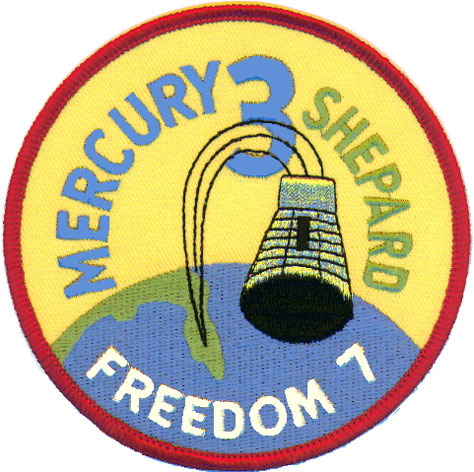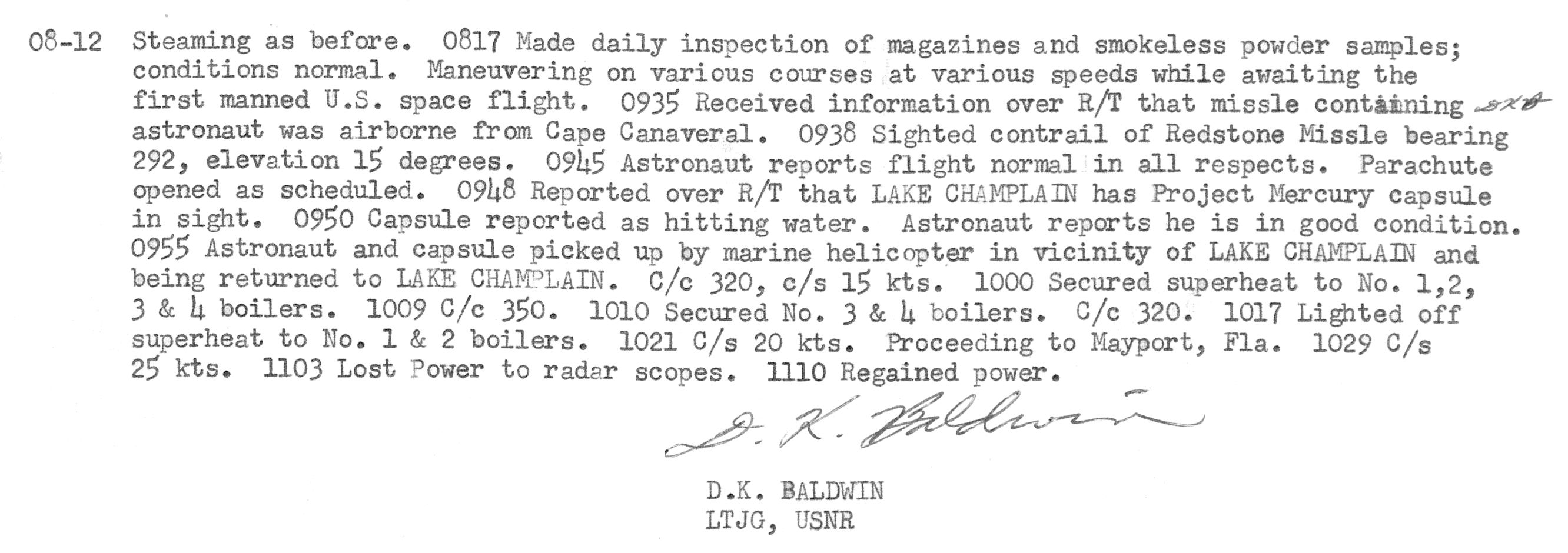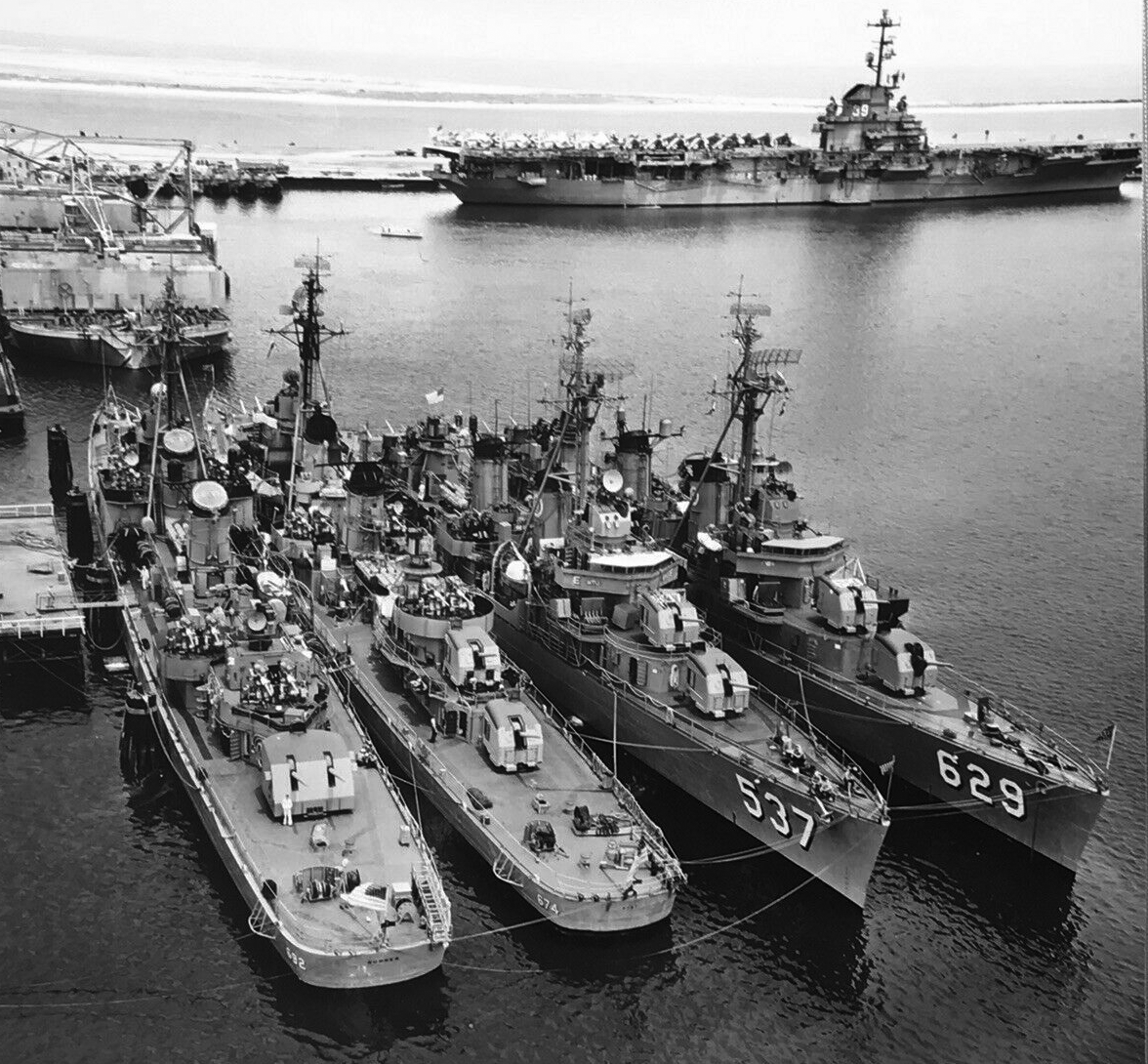Project Mercury
Abbot & The Space Race

On 5 May 1961, Abbot briefly entered the race for space.
Supporting the sub-orbital flight of Freedom 7, Abbot was detailed to help recover the Mercury capsule after splash-down roughly 300 miles east of Cape Canaveral, Florida. The crew practiced recovering a Mercury capsule in the weeks leading up to the launch.
The mission was designated MR-3, or Mercury-Redstone 3, and it was America’s answer to the successful flight of Yuri Gagarin, the Soviet cosmonaut who became the first human in space. Flown — or rather ridden — by Lt. Cdr. Alan B. Shepard Jr., Freedom 7 was America’s first attempt to put a human into space; the only previous Mercury passenger was a chimpanzee named Ham.
Freedom 7’s mission was to achieve a sub-orbital flight, shooting skyward from Florida and landing in the Atlantic Ocean about 15 minutes later. Navy ships would recover the capsule and its occupant, and Abbot would be part of the fleet. In the weeks leading up to the launch, Abbot practiced recovering a dummy Mercury space capsude.
The supporting ships under Rear Admiral G. P. Koch were the aircraft carrier Lake Champlain; the radar destroyer N.K. Perry; the destroyers Decatur, Wadleigh, Rooks, The Sullivans; and of course Abbot (under Commander Robert J. Norman). Some Lockheed P2V Neptune aircraft also assisted.
According to contemporary NASA documents:
The planning of recovery operations was as important as any other phase of the mission. Rear Admiral F. V. H. Hilles, in command of the experienced flotilla of eight destroyers known as DesFlotFour, worked with another flag officer, G[eorge] P. Koch, aboard the carrier Lake Champlain, on the tactics for this mission. STG’s primary strategy was to recover both man and capsule by using land-based marine helicopters for launch-site abort situations within about 80 miles of the Cape and carrier-based helicopters in the primary recovery area, within a hundred-mile radius.
Makeup of the recovery force was similar to that for MR-2, with tiered groups of men and equipment, beginning at Cape Canaveral, ready to cover all contingencies — abort, normal flight, or overflight. The main recovery force of ships was deployed in an elongated pattern 500 miles down along the range. It consisted of the carrier, eight destroyers, and one Atlantic Missile Range radar tracking ship. The helicopters again were manned by Marine Air Group 26, a veteran recovery unit.
Some innovations were added to the recovery plans as a result of experience gained in the MR-2 chimpanzee flight. For one thing, there was still the possibility that Freedom 7 might overshoot its landing target, in which case the time factor could be vital. Obviously a highly mobile unit was desirable. Walter Williams, operations director, requested an amphibian SA-16 aircraft with a pararescue team as an emergency rescue measure. Two such teams were provided, adding the support of the Air Rescue Service and navy frogmen to Project Mercury.
Project Mercury training for Abbot lasted most of April and early May (with a side-trip to Washington, D.C., for a visit by the secretary of the Navy, Pentagon officials and a congressional delegation). Log books for March, April and May 1961 reveal that Air Force personnel and a Navy physician were stationed aboard Abbot for the training and historic flight. The plan was to have Abbot patrol an area off Cape Canaveral designated as DD-2 in case the space capsule went off-course and splashed down too soon.
On March 30, just a few hours after arriving in Mayport, Florida, to begin Project Mercury training, Abbot ran aground on a sand bar and was towed off. A sailor reported that one of the ship’s two screws was scoured clean by the sand and a sonar dome was ruined, but otherwise damage was light and within 90 minutes Abbot was en route to the Cape Canaveral missile range to begin training.
Abbot’s participation was commemorated with a post card. The capsule weighed 2,316 pounds and was only 10 feet long and 6 feet wide, so a Fletcher-class destroyer could easily recover it and rescue the astronaut.
Here is the historic launch-day entry from Abbot’s log book:

In the end, the flight was nearly flawless and a helicopter from Lake Champlain recovered Shepard and Freedom 7. However, Abbot was ordered to patrol some very shallow water — too shallow, it turned out.
Mal Hill, who was aboard Abbot, said “I do know that we were steaming a figure 8 pattern at flank speed, 25 knots, in shallow water, and picking up mud from the bottom that regularly clogged our lube oil filters. A chief engineer’s nightmare!”
Photos left to right: Part of the Freedom 7 recovery fleet docked at Mayport, Florida, in late April 1961: The Essex-class aircraft carrier Lake Champlain (in background) and the Fletcher-class destroyers The Sullivans (hull number 537) and Abbot (629). Not part of the Freedom 7 fleet were the Sumner-class destroyer Allen M. Sumner (left) and the Fletcher-class destroyer Hunt (second from left), both awaiting major refits. Center photo shows Freedom 7’s launch atop a Redstone rocket at Cape Canaveral, Florida. Right photo shows astronaut Alan B. Shepard being hoisted aboard a Marine Corps H-34 helicopter dispatched from the aircraft carrier Lake Champlain.


